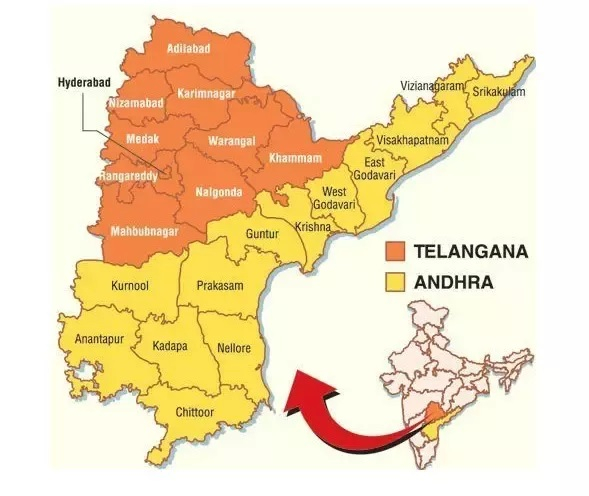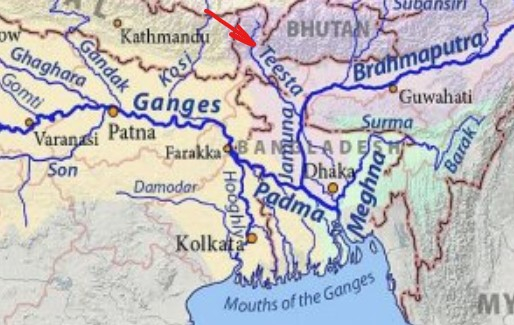Contents
- Centre says it has no role in picking capital
- Over 80% of students depend on mobiles: NCERT
- India to offer COVID-19 vaccine to Bangladesh
- New Ganga law will define cleanliness levels
CENTRE SAYS IT HAS NO ROLE IN PICKING CAPITAL
Focus: GS-II Governance
Why in news?
- The Central government has asserted that it has no role to play in determining the capital of Andhra Pradesh.
- The Centre said that the capital city of a state is decided by the respective state government.
The Story behind deciding the capital of Andhra Pradesh
Sri Krishna Committee report
- In 2010, a panel headed by Justice (Retd.) B.N. Srikrishna was formed to “bring about a permanent solution” to the Telangana statehood demand.
- In 2013, the Union Cabinet approved a Bill for the creation of Telangana State with 10 districts, paving the way for the bifurcation of Andhra Pradesh.
A.P. Reorganisation Bill

- The Bill envisages Hyderabad as the common capital. The Andhra Pradesh Governor will be Governor for both successor States of Andhra Pradesh and Telangana.
- The Centre will set up an apex council for the supervision of Krishna and Godavari rivers on water sharing.
- The High Court at Hyderabad will be common for both States till a separate High Court is set up for residuary Andhra Pradesh.
Regarding new capital for Andhra Pradesh
- Centre said it had formed an expert committee to study alternatives for a new capital for AP based on the AP Reorganization Act.
- The committee submitted its report based on which the government of AP notified that the capital city be named as Amaravati.
- The Andhra Pradesh state government, through the AP Decentralisation and Inclusive Development of all Regions Act, 2020, provided for three seats of governance — Amaravati, Visakhapatnam and Kurnool. (3 capitals).
Procedure for renaming a City
- The task of renaming a city is given to the State Legislators.
- The procedure differs from state to state but the regulations remains the same.
- The first step involves raising of a request in form of a resolution by any MLA, which proposes the renaming of any particular city or street.
- On the basis of the request of the MLA, the issue would be deliberated upon and the consequences of the same shall be discussed upon.
- The final step involves voting of the validity of the resolution.
- If a simple majority is attained in favour of the resolution, the said resolution shall be declared passed.
- The State Legislation on the basis of the majority view shall make the necessary changes in the name of the state or city public.
- The proposal will go to the Centre for approval before the city is officially renamed.
Procedure for renaming a state
- Unlike in the case of renaming cities, to change the name of a state, approval from the Centre’s Ministry of Home Affairs (MHA) is required under provisions laid down in its 1953 guidelines.
- This means that a Constitutional amendment becomes necessary to affect this change.
- The Union MHA then takes over and gives it consent after it receives No Objection Certificates (NOCs) from several agencies such as the Ministry of Railways, Intelligence Bureau, Department of Posts, Survey of India and Registrar General of India.
- If the proposal is accepted, the resolution, introduced as a Bill in the Parliament, becomes a law and the name of the state is changed thereafter.
Renaming states in the constitution
The Constitution of India provides for the renaming of a state under Article 3.
The Article 3 provides for formation of new States and alteration of areas, boundaries or names of existing States
- The procedure of renaming of the state can be initiated by either the Parliament or the State Legislator.
- A bill for renaming a state may be introduced in the Parliament on the recommendation of the President.
- Before the introduction of the bill, the President shall send the bill to the respective state assembly for expressing their views within a stipulated time.
- The views of the state assembly are not binding; neither on the President nor on the Parliament.
- But the process must not be skipped as it is of vital importance as any law so made will be affecting that particular state.
- On the expiry of the period, the bill will be sent to the Parliament for deliberation.
- The bill in order to take the force of a law must be passed by a simple majority.
- The bill is sent for approval to the President.
- After the approval of the said bill, the bill becomes a law and the name of the state stands modified.
-Source: The Hindu
OVER 80% OF STUDENTS DEPEND ON MOBILES: NCERT
Focus: GS-II Social Justice
Why in news?
- School education in the time of COVID is heavily dependent on mobile phones, with 80-90% of older students in Central government schools saying they use mobiles rather than laptops to access digital schooling during the pandemic, according to an official sample survey conducted by the National Council of Educational Research and Training (NCERT).
- Almost 30% said absent or intermittent electricity connections hindered their learning, and half the students said they did not even have access to their textbooks.
Details
- The situation is likely to be far grimmer at state-funded schools and the poorer private schools where the majority of students study.
- Only four States have completed mapping of the devices available to students — smartphone, basic mobile, radio, TV, personal or community computer — according to the Students’ Learning Enhancement Guidelines released by the Education Ministry.
- According to the NCERT survey, most of 40% of students in CBSE schools said they found online learning difficult or burdensome.
- 27% did not have either laptops or smartphones.
- Half the surveyed students did not have textbook access, and 28% faced electricity problems.
- Paucity of devices among teachers and their unfamiliarity with the devices and online teaching methods also created roadblocks.
- The reported suggested that states undertake a school-wise and student-wise survey to map the digital device accessibility.
-Source: The Hindu, Hindustan Times
INDIA TO OFFER COVID-19 VACCINE TO BANGLADESH
Focus: GS-III International Relations
Why in news?
Bangladesh will receive COVID-19 vaccine from India on a priority basis, a top diplomat of Dhaka said.
Details
- Regarding the vaccine from India’s Serum Institute, the foreign secretary of Bangladesh said that Bangladesh has been assured that India will provide the COVID-19 vaccine to them on a priority basis.
- This comes weeks after the Bangladesh Medical Research Council (BMRC) allowed China to carry out the Phase III human trial of the anti-COVID-19 vaccine; and China had also sent a medical team to assess the pandemic preparation of Bangladesh.
Other concerns raised
- The Bangladeshi diplomat also directed attention towards the killings of Bangladesh nationals along the border, saying at least 25 Bangladesh nationals have been killed in firing from the BSF till the summer of 2020.
- Bangladesh has asked India to use its non-permanent membership at the UN Security Council during 2021 to increase pressure on Myanmar for the repatriation of the Rohingya refugees.
- It was also said that like China, India too should provide tariff-free facility for exports from Bangladesh.
Recent developments: Teesta project
- The Bangladeshi government has recently reached an agreement with China over building of a $1 billion irrigation project at the Teesta which will benefit the country’s farmers in the Rangpur region during the lean seasons.
- Construction of the project will effectively neutralise the Teesta water negotiations with India.
Teesta River

- Teesta River rises in the eastern Himalayas, flows through the Indian states of Sikkim and West Bengal through Bangladesh and enters the Bay of Bengal.
- It forms the border between Sikkim and West Bengal.
- It joins the Jamuna River at Fulchhari in Bangladesh.
- The Teesta River originates from the Pahunri (or Teesta Kangse) glacier.
Baraiyarhat-Heyanko and Ramgarh Highway
- The Bangladeshi Government has cleared the plan for a major highway project that will connect Baraiyarhat-Heyanko and Ramgarh of northern Chittagong near the borders with the northeastern State of Tripura.
- The Rs. 1,000-crore project will help the northeast region by connecting with Chittagong as well as its port which can emerge as a gateway to the northeast.
-Source: The Hindu
NEW GANGA LAW WILL DEFINE CLEANLINESS LEVELS
Focus: GS-III Environment and Ecology
Why in news?
- The Union government plans to bring a new legislation to keep the Ganga river, clean and pollution-free.
- A draft of the proposed law is currently being vetted by multiple authorities before it will be sent for the Cabinet’s approval.
Background
- The government started the Namami Gange campaign to clean the Ganga, one of the world’s most polluted rivers with sewage and industrial waste discharged into it for decades.
- Millions of Hindus worship the 1,560-mile (2510 km) river. The Ganga basin supports over 400 million of India’s 1.3 billion people.
- Efforts to rid the river of pollutants go back to 1980s, marked by two successive programmes known as Ganga Action Plans.
- Under the “subject” of water in the Constitution, the Union has extensive powers to bring laws to protect rivers from pollution.
Details
- The proposed law now being drafted will set down legal obligations to prevent pollution, fix biological and effluent parameters to be maintained at all times at key geographical points and cities through which the river flows.
- The eight states of the Ganga basin. where the proposed law will be especially applicable are Uttarakhand, Uttar Pradesh, Bihar, Jharkhand, West Bengal, Delhi, Haryana, and Himachal Pradesh.
- The proposed law will have a ‘polluters-pay’ approach, which means illegal factories will be shut down — many have already been closed– and permitted ones will be required to treat their sewage.
- Certain types of polluting factories will be banned from discharging any sewage into the river.
Steps taken so far
- Nearly 704 industries along the Ganga’s banks were inspected by the National Ganga River Basin Authority (NGRBA).
- Three-fifths of them have been shut down.
- Nearly 500 massive sewage trapping devices have been installed so far.
- Of the 29 major nullahs (storm drains) flowing into the river in Varanasi, 27 now have systems to capture waste.
-Source: Hindustan Times



